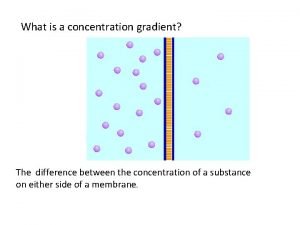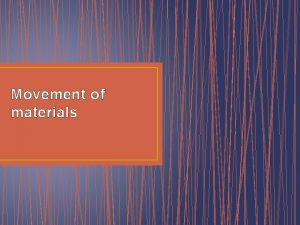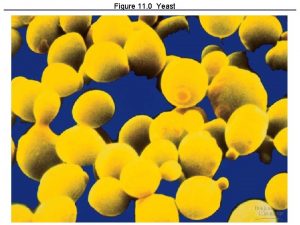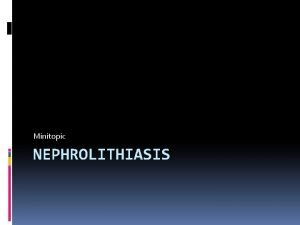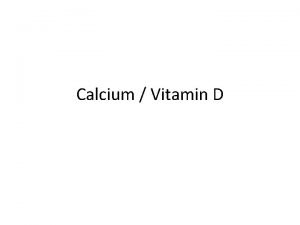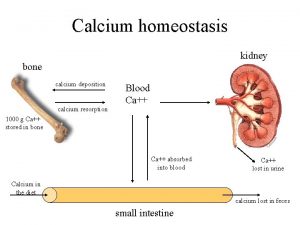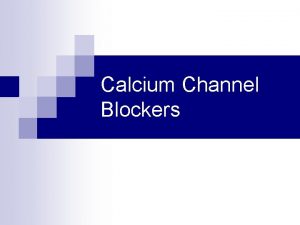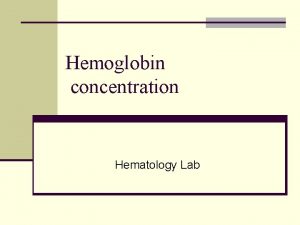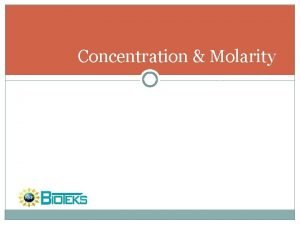Calcium signaling Ca The low concentration of calcium







- Slides: 7

Calcium signaling Ca++ • • • The low concentration of calcium in the cytosol allows this ion to function as a second messenger in calcium signaling. Here, a signal such as a hormone or an action potential opens calcium channels so that calcium floods into the cytosol. This sudden increase in cytosolic calcium activates other signalling molecules, such as calmodulin and protein kinase C. Small molecules diffuse rapidly in the cytosol, concentration gradients can still be produced within this compartment. A well-studied example of these are the "calcium sparks" that are produced for a short period in the region around an open calcium channel. These are about 2 micrometres in diameter and last for only a few milliseconds, although several sparks can merge to form larger gradients, called "calcium waves".

Ca++ ions as messenger • Important physiological roles for calcium signaling range widely. • These include muscle contraction, neuronal transmission as in an excitatory synapse, cellular motility (including the movement of flagella and cilia), fertilization, cell growth or proliferation, learning and memory as with synaptic plasticity, and secretion of saliva. • Other biochemical roles of calcium include regulating enzyme activity, permeability of ion channels, activity of ion pumps, and components of the cytoskeleton.

Contd………… • The resting concentration of Ca 2+ in the cytoplasm is normally maintained in the range of 10– 100 n. M. To maintain this low concentration, Ca 2+ is actively pumped from the cytosol to the extracellular space and into the endoplasmic reticulum (ER), and sometimes in the mitochondria. • Certain proteins of the cytoplasm and organelles act as buffers by binding Ca 2+. • Calcium channel blockers are used to treat hypertension, chest pain and heart pain. A calcium channel blocker (CCB) is a chemical that disrupts the movement of calcium (Ca 2+) through calcium channels.

The 2+ Ca ATPases • A Ca 2+ ATPase is located in the plasma membrane of all eukaryotic cells. It uses the energy provided by one molecule of ATP to pump one Ca 2+ ion out of the cell. • The activity of these pumps helps to maintain the ~20, 000 -fold concentration gradient of Ca 2+ between the cytosol (~ 100 n. M) and the ECF (~ 20 m. M). • In resting skeletal muscle, there is a much higher concentration of calcium ions (Ca 2+) in the sarcoplasmic reticulum than in the cytosol. Activation of the muscle fiber allows some of this Ca 2+ to pass by facilitated diffusion into the cytosol where it triggers contraction.

• After contraction, this Ca 2+ is pumped back into the sarcoplasmic reticulum. This is done by another Ca 2+ ATPase that uses the energy from each molecule of ATP to pump 2 Ca 2+ ions. • These sodium/potassium and calcium pumps are called P-type ion transporters because they use the same basic mechanism: a conformational change in the proteins as they are reversibly phosphorylated by ATP. And all three pumps can be made to run backward. That is, if the pumped ions are allowed to diffuse back through the membrane complex, ATP can be synthesized from ADP and inorganic phosphate.

The + + H /K ATPase • The parietal cells of your stomach use this pump to secrete gastric juice. These cells transport protons (H+) from a concentration of about 4 x 10 -8 M within the cell to a concentration of about 0. 15 M in the gastric juice (giving it a p. H close to 1). • It is a great wonder that parietal cells are stuffed with mitochondria and uses huge amounts of ATP as they carry out this three-million fold concentration of protons.

Some inherited ion-channel diseases • • A growing number of human diseases have been discovered to be caused by inherited mutations in genes encoding channels. Some examples: Chloride-channel diseases – cystic fibrosis; – inherited tendency to kidney stones (caused by a different kind of chloride channel than the one involved in cystic fibrosis). Potassium-channel diseases – the majority of cases of long QT syndrome, an inherited disorder of the heartbeat; – a rare, inherited tendency to epileptic seizures in the newborn; – several types of inherited deafness Sodium-channel diseases – inherited tendency to certain types of muscle spasms; – Liddle's syndrome. Inadequate sodium transport out of the kidneys, because of a mutant sodium channel, leads to elevated osmotic pressure of the blood and resulting hypertension (high blood pressure).

